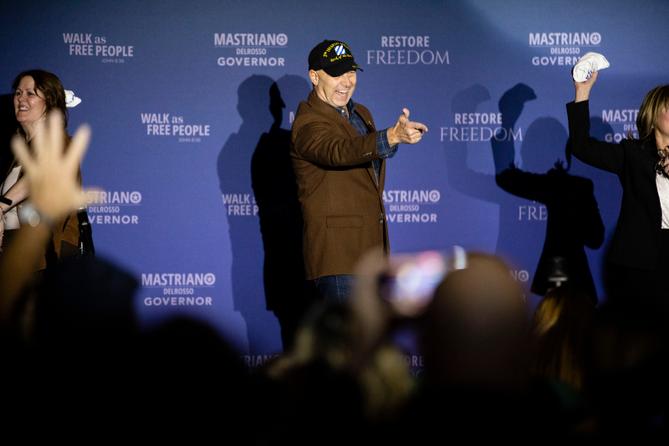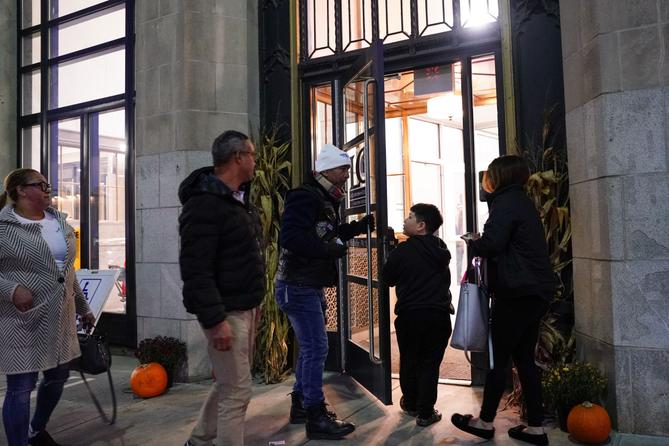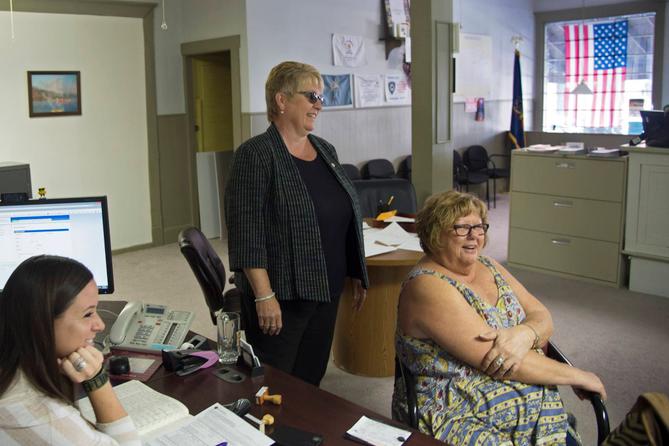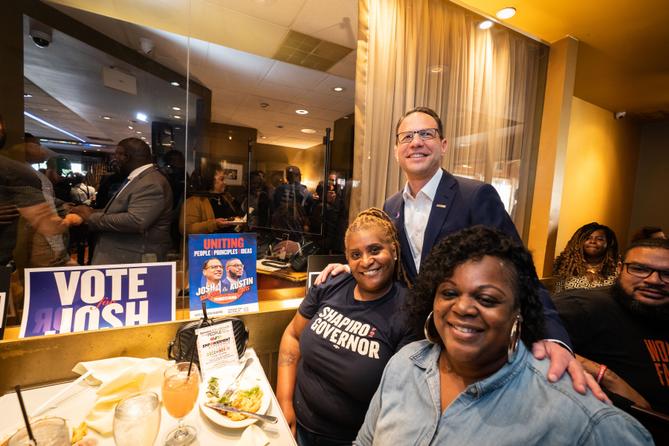Spotlight PA is an independent, nonpartisan newsroom powered by The Philadelphia Inquirer in partnership with PennLive/The Patriot-News, TribLIVE/Pittsburgh Tribune-Review, and WITF Public Media. Sign up for our free newsletters.
HARRISBURG — In his successful bid for Pennsylvania governor, Josh Shapiro received more votes than any other gubernatorial candidate in commonwealth history.
And he didn’t just get a lot of votes. The attorney general also won by a margin not often seen in an open race — trouncing GOP candidate Doug Mastriano by nearly 15 points, according to unofficial results, and driving down margins in counties some state and national Democrats have written off in recent years.
Now the political world is figuring out what lessons to take from that victory.
Analysts, activists, campaign operatives, supporters, and detractors all tend to agree that a few key things sealed the deal for Shapiro: a politically extreme, cash-poor opponent in Mastriano, strong outreach to rural areas Democrats sometimes neglect, and a pragmatic — and at times, flexible — policy message that appealed to voters in populous urban and suburban areas, as well as those in rural communities.
But some observers are also focusing on areas where Shapiro’s results were weaker.
Turnout — which is important for Democrats in vote-rich strongholds like big cities — was low in Philadelphia relative to other parts of the commonwealth. This was especially the case in poorer, heavily Black and Hispanic precincts. And outside Philly, turnout was also relatively weak in smaller cities where lots of Black and Latino people live, such as Allentown, Hazleton, and Reading.

The Doug effect
It’s impossible to talk about Shapiro’s victory without talking about his opponent, far-right state Sen. Doug Mastriano of Franklin County.
Mastriano had quickly moved from the fringe of his party to its center before the election, propelled by his commitment to conspiracy theories about widespread 2020 election fraud. By the time he emerged from a bruising primary with little support from mainstream Republicans, Shapiro had spent his uncontested primary raising tens of millions of dollars and building campaign infrastructure across the state.
Mastriano never amassed much of a campaign chest or mainstream following, and it showed in both his limited fundraising and his insular events. Meanwhile, Shapiro broke spending records. This allowed Shapiro’s campaign to run ad after TV ad across the state portraying Mastriano as a dangerous radical and Shapiro as a reasonable consensus-builder.
Mastriano remained totally off-air for most of the race.
In their election post-mortems, Republicans’ complaints go beyond Mastriano’s campaign decisions. They blame a lack of a clear message and little institutional guidance from the state Republican Party for their generally disastrous results, which include losing the state House for the first time since 2010.
While Shapiro was out creating a unifying platform that all Democrats could run under, Mastriano’s refusal to talk to the mainstream press and lack of advertising allowed his opponents to define his campaign to swing voters, said Jeff Coleman, a former state legislator for Armstrong County and current GOP campaign strategist.
Mastriano and his backers argued that grassroots enthusiasm in redder, rural areas would overcome the deficits in more moderate suburbs. But Dean Browning, an unsuccessful GOP candidate for state Senate in the Lehigh Valley, did not see any carryover.
Mastriano “did nothing to counter any of the charges against him,” Browning told Spotlight PA. “I did not see anything in the way of mail. He purported to have a huge grassroots because he got 30,000 signatures to get on the ballot, but I didn’t see them on the ground.”
Meanwhile, Browning and other Republican legislative candidates were hit with “cookie-cutter ads,” he said, connecting the individual candidates to Mastriano’s support for criminalizing abortion, overturning the 2020 election, and cutting public education spending.
Those advantages gave Democrats a powerful cudgel against the GOP up and down the ticket. Beyond winning open races, the party also knocked off four GOP incumbents in suburban Philadelphia to win a one-vote state House majority — putting Republicans in the minority for the first time in 12 years.
The loss has led to widespread discontent among legislative Republicans, all of whom agree that the party needs a legible policy platform and clearer messaging.
“We just assumed ‘Biden’s unpopular, gas prices are high,’” said state Rep. Jesse Topper (R., Bedford). “But where was Newt Gingrich’s Contract With America? Where was that with the American people or the Commonwealth of Pennsylvania? A plan for changing things for people.”
Topper did not specify what policies he hoped to pursue.

Become a Luzerne County resident (almost)
University of Pittsburgh political analyst Lara Putnam, who already has been combing over available 2022 election data, pointed out a few areas of the state where Shapiro’s results were especially notable.
“Basically Shapiro hung onto all the Biden voters and had unusually large numbers of them actually voting in the midterm elections … and then additionally, he persuaded some Trump voters,” she said. “So he benefited from both swinging the votes of some number of independents, and he benefited from maintaining strong turnout among sometimes-voters, most strongly in upscale suburbs and exurbs.”
Shapiro’s campaign staff, and the local leaders who supported him, attributed some of this success to Mastriano’s unpopularity, but argued the campaign’s commitment to travel also played a role. That strategy emerged from failure, they noted.
Among people who work on and with Democratic campaigns, Hillary Clinton’s 2016 campaign, with its firm focus on Pennsylvania’s cities and big suburbs, has become a model of how not to run a race in the state.
Kathy Bozinski, who chairs the Democratic committee in Luzerne County, where Clinton notoriously lost six years ago, said that “to this day … people will shake their heads and say, Hillary Clinton never came here. She didn’t care about us.”
In the opposite corner of the state, Democratic state Rep. Pam Snyder of Greene County said of Clinton, “I don’t think she paid enough attention to rural America.”
“The candidates, I think, have woken up to the fact that they can’t hang their hat on Philly and Pittsburgh anymore,” said Jeff Eggleston, a Democratic county commissioner in Warren County, in the northern tier. “There have been too many losses, too many narrow wins.”
Biden increased in-person stops during his 2020 bid for the presidency. And Shapiro’s campaign, organizers said, really took the every-county approach to heart.
“I joked to him, ‘I think you just need to, like, buy a house here already, you’re here once a month,’” Bozinski said of Shapiro’s visits to Luzerne. “I think it paid off for him.”
Some of Shapiro’s ventures into less friendly territories were fraught.
Patrick Joyal, who was Shapiro’s deputy political director, spent the early months of Shapiro’s uncontested primary talking to people he calls “community validators” — county commissioners, township supervisors, sheriffs, and other elected officials. Many were Democrats; some were Republicans.
In December 2021, the Shapiro campaign tapped some of these allies, such as Butler County Commissioner Kevin Boozel, to ask around and find voters who were open to a conversation with Shapiro.
Not all were on board with his candidacy, but 10 people assembled in a hunting club in Butler County in December 2021, Joyal said.
“It was a very frank and honest conversation, and there were certain moments where there was outright disagreement,” Joyal said. At one point, Shapiro and Boozel tangled with a business owner who opposed COVID-19-induced shutdowns. They also clashed with a young mother who did not want to vaccinate her kids.
But Joyal said the conversations were worthwhile: “I really believe that a bunch of those folks, even if they didn’t vote for the governor-elect, felt respected, felt heard.”

In statewide messaging, ‘one-size-fits-all’ doesn’t work
Among the Shapiro campaign’s many ads were spots calibrated to very specific audiences — like a TV ad run mostly in the Pittsburgh, State College/Johnstown, and Scranton media markets highlighting Shapiro’s suit against a contractor for prevailing wage theft, and another, run in similar markets, that focused on Shapiro’s opposition to proposed change to tipping law that the Trump administration had pitched.
This approach made sense to county Democratic operatives, like Bozinski of Luzerne.
“The Democratic Party is such a big-tent party,” she said. “It’s definitely not a one-size-fits-all message. I’ve looked at Luzerne County as an illustration of that. We’ve got some very conservative Democrats, some very progressive Democrats here.”
Snyder, who will retire from the state House at the end of this year’s legislative session, has for nearly a decade represented a seat in the far southwestern corner of Pennsylvania. Her district, like much of that region, has gotten increasingly Republican during her tenure — a process she says accelerated rapidly with Donald Trump’s 2016 election.
She said Shapiro’s rhetoric mattered as much as his presence. In Snyder’s estimation, the main thing that has turned people in her district off from Democrats is what she sees as a misunderstanding of the party platform on issues like energy. Her district has two producing coal mines and a good number of natural gas jobs and Snyder, for one, supports their continued operation. But she thinks there’s a broad perception that Democrats want to stop the use of fossil fuels.
On the campaign trail, Shapiro talked about transitioning to renewable energy sources but he also stressed that he thinks fossil fuels are currently indispensable. He avoided taking a firm position on the Regional Greenhouse Gas Initiative, a pledge in which states commit to reducing emissions by requiring fossil fuel power plants to purchase allowances to emit carbon dioxide.
RGGI is one of Democratic Gov. Tom Wolf’s signature energy policies. At a recent news conference on the gubernatorial transition, Shapiro told reporters he’ll assemble a working group to assess it.
“One of the reasons why I was so involved in his campaign is because I see [Shapiro] as a Democrat like me: pragmatic,” Snyder said. “You want to come to the center and find solutions. You want to do your job without the obstructionists getting in the way.”
One of the campaign’s bigger events in Greene County was hosted in a barn on Snyder’s family farm. People there, she said, seemed “starved” for elected officials to take a personal interest in their problems.
“We packed the place,” she said. “I was so happy because Greene County has become a county where, you know, if you’re able to put 20 Democrats in a room for an event, you’re lucky.”
Snyder’s collaborations with Shapiro aren’t ending with the campaign. This week, she was named — along with a who’s who of other politicians and powerful people — to the leadership board of Shapiro’s gubernatorial transition team.

City problems
Putnam noted that the only areas where Shapiro consistently did not see extremely impressive turnout numbers relative to previous elections were “the most economically marginal, heavily minority” neighborhoods in Pittsburgh and Philadelphia, as well as in smaller cities like Allentown, Hazleton, and Reading.
This election was not a presidential one, she noted, so some turnout decline is expected. “But that decline was much sharper in urban core areas, including in urban core areas where 2018 had seen strong turnout,” Putnam added.
This does not mean cities had terrible turnout. In Philadelphia, for instance, overall 2022 turnout was lower than in 2018 but higher than any other midterm in recent history. But turnout in these areas dropped more from 2020 than in other parts of the commonwealth, i.e. it was lower relative to most of the state — an issue, Putnam said, that seems to be larger than any one campaign.
“The same pattern basically appeared nationwide this year in disadvantaged urban core areas and in heavily African American areas.”
It’s always difficult to take specific lessons from broad turnout trends, but Putnam pointed out one more data point that she thinks sheds light on Shapiro’s relatively weak showing in poor urban areas: comparison with Lt. Gov. John Fetterman’s successful campaign for U.S. Senate.
Shapiro achieved better margins than Fetterman across most of the state — which Putnam mostly attributes to the fact that Fetterman had a relatively more formidable opponent in Mehmet Oz. But repeatedly in poor, heavily Black and Latino urban neighborhoods, Fetterman’s results were much closer to Shapiro’s — i.e., he did comparatively better in those areas.
Putnam did not have a firm answer as to why. But she said the reason could indicate what messaging works in these areas.
“Maybe people should start thinking, for instance, that being associated with criminal justice reform, legalization of marijuana, clemency, critique of the carceral system — maybe that’s a good thing for Democrats in places where folks haven’t been turning out to vote recently,” she said.
On the ground, canvassers said they repeatedly encountered this kind of attitude in relatively poor, urban neighborhoods.
The union Unite Here, which primarily represents hotel, food service, and airport workers, among others, knocked on over 980,000 doors in Pennsylvania this year for Fetterman and Shapiro, which made it the biggest door-to-door effort on Fetterman and Shapiro’s behalves in the commonwealth.
They worked primarily in Philadelphia and its immediate suburbs, but also in Reading, and focused on precisely the kinds of voters Shapiro struggled to attract: people who were poorer, and less likely to vote. Their strategy included offering job training and connections at the door, noted Rosslyn Wuchinich, who is a president of Unite Here Local 274 and served as campaign director for the effort.
Tim Freeman, a Philly-based hotel worker who serves as a steward and worked as a 2022 organizer, said people he spoke to at the door often didn’t know it was an election year, or didn’t realize Fetterman and Shapiro were both Democrats. And a good number, he said, were burned out on voting entirely.
“A lot of people were saying that they really didn’t care for voting because they didn’t see things change,” he said.
But there were a couple strategies he found effective. People really responded to a reminder that abortion could be restricted, and that Mastriano supported those restrictions. Freeman talked frequently about Shapiro’s pledges to fund public education.
But one of the main strategies he used didn’t have much to do with the candidates at all — it had to do with him, the messenger.
Freeman was shot in the leg in 2019 — a case of “wrong place at the wrong time,” he said. That’s a fear and reality that people respond to and it gave him credibility, he said.
“By using them things and letting them know what’s at stake, like with the gun control laws … people open up and really understand the importance of getting out there,” he said, adding that in-person pitches always beat TV ads.
“Because we share our stories,” he said. “We want to hear their stories as well.”
WHILE YOU’RE HERE… If you learned something from this story, pay it forward and become a member of Spotlight PA so someone else can in the future at spotlightpa.org/donate. Spotlight PA is funded by foundations and readers like you who are committed to accountability journalism that gets results.

